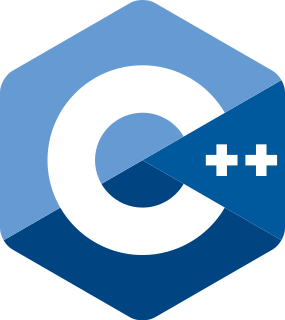In object-oriented programming, a class is an extensible program-code-template for creating objects, providing initial values for state and implementations of behavior. In many languages, the class name is used as the name for the class, the name for the default constructor of the class, and as the type of objects generated by instantiating the class; these distinct concepts are easily conflated.
Knowledge representation and reasoning is the field of artificial intelligence (AI) dedicated to representing information about the world in a form that a computer system can utilize to solve complex tasks such as diagnosing a medical condition or having a dialog in a natural language. Knowledge representation incorporates findings from psychology about how humans solve problems and represent knowledge in order to design, formalisms that will make complex systems easier to design and build. Knowledge representation and reasoning also incorporates findings from logic to automate various kinds of reasoning, such as the application of rules or the relations of sets and subsets.
Planner is a programming language designed by Carl Hewitt at MIT, and first published in 1969. First, subsets such as Micro-Planner and Pico-Planner were implemented, and then essentially the whole language was implemented as Popler by Julian Davies at the University of Edinburgh in the POP-2 programming language. Derivations such as QA4, Conniver, QLISP and Ether were important tools in artificial intelligence research in the 1970s, which influenced commercial developments such as KEE and ART.
In software engineering and computer science, abstraction is:
A specification language is a formal language in computer science used during systems analysis, requirements analysis, and systems design to describe a system at a much higher level than a programming language, which is used to produce the executable code for a system.
In computer science, an object can be a variable, a data structure, a function, or a method, and as such, is a value in memory referenced by an identifier.
Programming paradigms are a way to classify programming languages based on their features. Languages can be classified into multiple paradigms.
In computer science, imperative programming is a programming paradigm that uses statements that change a program's state. In much the same way that the imperative mood in natural languages expresses commands, an imperative program consists of commands for the computer to perform. Imperative programming focuses on describing how a program operates.
A method in object-oriented programming (OOP) is a procedure associated with a message and an object. An object consists of data and behavior. The data and behavior comprise an interface, which specifies how the object may be utilized by any of various consumers of the object.
An object language is a language which is the "object" of study in various fields including logic, linguistics, mathematics, and theoretical computer science. The language being used to talk about an object language is called a metalanguage. An object language may be a formal or natural language.
CLIPS is a public domain software tool for building expert systems. The name is an acronym for "C Language Integrated Production System." The syntax and name was inspired by Charles Forgy's OPS. The first versions of CLIPS were developed starting in 1985 at NASA-Johnson Space Center until the mid-1990s when the development group's responsibilities ceased to focus on expert system technology. The original name of the project was NASA's AI Language (NAIL).
In the field of Artificial Intelligence, inference engine is a component of the system that applies logical rules to the knowledge base to deduce new information. The first inference engines were components of expert systems. The typical expert system consisted of a knowledge base and an inference engine. The knowledge base stored facts about the world. The inference engine applies logical rules to the knowledge base and deduced new knowledge. This process would iterate as each new fact in the knowledge base could trigger additional rules in the inference engine. Inference engines work primarily in one of two modes either special rule or facts: forward chaining and backward chaining. Forward chaining starts with the known facts and asserts new facts. Backward chaining starts with goals, and works backward to determine what facts must be asserted so that the goals can be achieved.
A frame language is a technology used for knowledge representation in artificial intelligence. Frames are stored as ontologies of sets and subsets of the frame concepts. They are similar to class hierarchies in object-oriented languages although their fundamental design goals are different. Frames are focused on explicit and intuitive representation of knowledge whereas objects focus on encapsulation and information hiding. Frames originated in AI research and objects primarily in software engineering. However, in practice the techniques and capabilities of frame and object-oriented languages overlap significantly.
In computer science, a relational operator is a programming language construct or operator that tests or defines some kind of relation between two entities. These include numerical equality and inequalities.
The object-relational impedance mismatch is a set of conceptual and technical difficulties that are often encountered when a relational database management system (RDBMS) is being served by an application program written in an object-oriented programming language or style, particularly because objects or class definitions must be mapped to database tables defined by a relational schema.
A production system is a computer program typically used to provide some form of artificial intelligence, which consists primarily of a set of rules about behavior but it also includes the mechanism necessary to follow those rules as the system responds to states of the world. Those rules, termed productions, are a basic representation found useful in automated planning, expert systems and action selection.

Carl Eddie Hewitt is an American computer scientist who designed the Planner programming language for automated planning and the actor model of concurrent computation, which have been influential in the development of logic, functional and object-oriented programming. Planner was the first programming language based on procedural plans invoked using pattern-directed invocation from assertions and goals. The actor model influenced the development of the Scheme programming language, the π-calculus, and served as an inspiration for several other programming languages.


